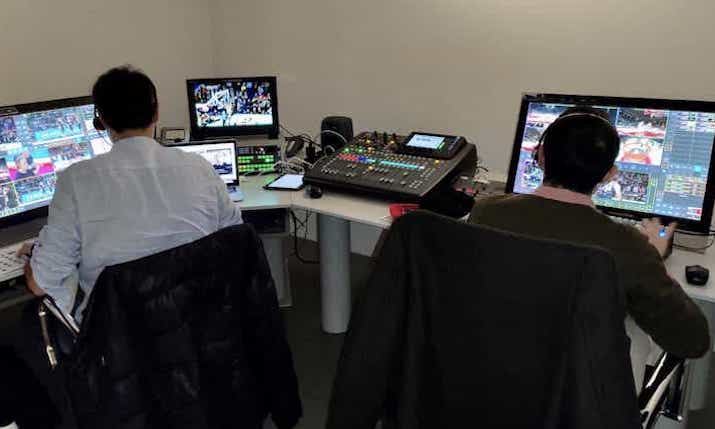Finding the right level: EMG Italy’s Francesco Donato on the advantages offered by remote production

EMG Italy CTO Francesco Donato
With more than five years of experience in utilising remote production techniques for sporting events across Italy, Francesco Donato, CTO at EMG Italy, speaks to Roberto Landini about the opportunities it offers in terms of workflow efficiencies and meeting the demand for more content on more platforms.
Is it correct to think that there are multiple levels of remote production that can be implemented depending on budget and the importance of the event?
Of course. The conditions of the large television production market have changed a lot today. If we focus only on remote production, there are different ways to do this. There is a relatively ‘light’ version, which usually is confined to the use of one, two, or three TV cameras managed remotely at a remote operation centre, and a more ‘heavy remote’ that can manage 5-8 cameras and often requires an outside broadcast vehicle at the stadium.
In the case of ‘light’ remote production, is the OB van no longer a necessity?
In television production, market conditions have changed, and margins are significantly reduced.
With a heavy remote setup configuration, an OB unit must be at the venue and therefore the costs are higher, while a light remote setup configuration requires a lower commitment of resources and, if the editorial plan is designed to adapt to the technique on field, then it is certainly possible to bring the operating margin back within limits that justify the activity.
The advantage of the light solution, above all, is in the efficiency of the production and creation processes as it allows for product uniformity in terms of quality and narrative.
It is clear that the presence and supervision of the editorial team at the remote operation centre allows the publisher to have precise and timely control of the entire supply chain, from capture to delivery of the product, including multi-platform.
What are the general reasons that remote production entered the market and what real advantages does it bring?
Many think that remote production is born only for the optimisation of costs in response to the contraction of the market and investments, and because of the social distancing needs created by the pandemic.
For us in Italy who have already been using it for more than five years, this is not the case, and the use of these recent remote production techniques means being able to create better production flows, both linear and on demand, to obtain complete product packaging on different outputs as required today by digital markets.
Which markets in Italy are most interested in remote production?
For the moment in Italy we have consolidated ourselves as a leader in the smaller market segments, but we also have solutions that allow you to export the concept of remote realisation to top tier sport markets.
Certainly, in recent years, we have presided over and reached a position of reference in the remote production market and we believe that, with our activity and the trust of broadcasters, we have managed to allow the use of RP in sports disciplines that otherwise would not have had the presence and visibility that they have today.
Another growing sector is the corporate market, in which it is necessary to manage more institutional events; and this applies to all sectors, from fashion to banks to all markets in general, to cover the requests for efficiency of B2B and B2C communication.
Is it true that remote production leads to greater levels of efficiency?
In a way it does, but it needs nuance: producing many events does not always mean being efficient.
In reality, it is important to understand that efficiency is achieved only when you have the ability to maximise the use of production solutions. In other words, we could say that the greater the investment, the greater the costs, but if this cost is spread more precisely and not only – as often happens – during actual events, i.e. during the weekend, but even during the week, then you get the great efficiency that everybody will like.
At the moment, how is the remote production line organised and what management capacity does EMG Italy have?
In the case of EMG Italy we have 26 production lines that cover the traffic generated in two or three days. This forces us to use a large number of technical and human resources.
Our Remote Production Center in Milan is now able to produce almost 2,000 events a year just for sport. The productions are normally ‘light’ versions made with single, double and tri-camera setups.
As previously stated, we are able to deliver both linear television content, as well as digital and VOD.
So, is it correct to think that it is, above all, the calendar of events that determines whether or not the entire system is efficient or not?
The calendar of sporting events is crucial, but it must be said that the programming of events is designed to capture the presence and availability of the public who clearly have different habits, which often do not coincide with our search for efficiency.

What other advantages can be identified by opting for remote production?
RP allows better production flows and, above all, the immediate delivery of linear, OTT and on demand content.
Traditional broadcasters maintain their positions, but these have been joined by digital platform broadcasters who have other and very different needs in terms of publication. From the production centre we are able to feed the new platforms adequately, which we could not do from the playing field.
The big difference with remote production compared to traditional production is actually in the packaging of the product, because with it we are able to compose the contents as needed for different media and different devices, and distribute such versions as we could not do before.
Does remote production therefore become decisive in the distribution of digital content on OTT and VOD platforms?
In fact, the big difference resides mainly in the variation of the product being quite different: from linear to VOD, it is only remote production that allows you to manage these processes that otherwise in the field, in a fragmented production regime such as the traditional one, could not be achieved.
With EMG Italy, the factors that decisively influence one choice rather than another concern, first of all, the understanding of the conditions in which the activities are required to be carried out.
Moreover, traditional television is no longer the only way to distribute content and remote production is the perfect way to deliver on a multi-platform basis.
For EMG Italy, remote production is above all a way of maximising the use of resources while creating services and products that were previously not economically viable.

